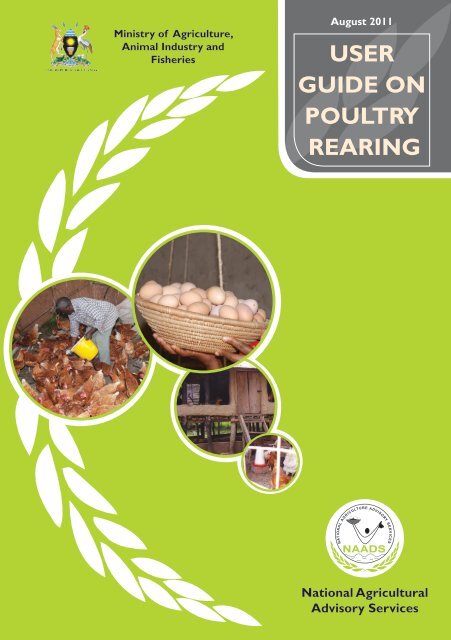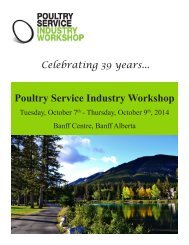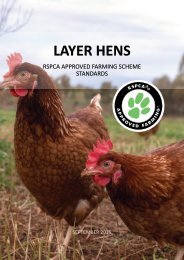POULTRY REARING
You also want an ePaper? Increase the reach of your titles
YUMPU automatically turns print PDFs into web optimized ePapers that Google loves.
Ministry of Agriculture,<br />
Animal Industry and<br />
Fisheries<br />
August 2011<br />
USER<br />
GUIDE ON<br />
<strong>POULTRY</strong><br />
<strong>REARING</strong><br />
National Agricultural<br />
Advisory Services
NAADS - July 2011<br />
Poultry Rearing<br />
<strong>POULTRY</strong> <strong>REARING</strong><br />
Poultry contributes to improved human nutrition and food security by being a<br />
leading source of high quality protein in form of eggs and meat. It acts as a key<br />
supplement to revenue from crops and other livestock enterprises, thus avoiding<br />
over dependency on traditional commodities with inconsistent prices. It has a high<br />
potential to generate foreign exchange earnings through export of poultry products<br />
to neighboring countries. Poultry is highly prized in many social-cultural functions<br />
such as dowry and festivities. The poultry industry in Uganda is relatively new. Its<br />
major problem is therefore associated with its further expansion, though care<br />
must be taken to avoid overproduction. The industry is characterized by widely<br />
diverse methods of production which include the following: village flocks, smallscale<br />
commercial flocks and large-scale commercial farms. Constraints in poultry<br />
production include: production related constraints (inadequate access to improved<br />
breed, access and affordability of feed, disease control); lack of knowledge and skills,<br />
inadequate capital at all levels and marketing.<br />
Systems of Management<br />
• Free range<br />
• Semi-intensive<br />
• Intensive<br />
Housing: essential features<br />
• Building a large poultry house ideal for chicken<br />
• Be rainproof<br />
• Be secure from windy rains<br />
• Have smooth surface walls to stop mites and other pests from hiding<br />
• Periodically spraying the poultry unit with insecticide and disinfectants<br />
• Periodically removing the dropping/cleaning the poultry house regularly<br />
• Have good ventilation and in hotter areas at least 2 sides should be partly<br />
chicken wire mesh<br />
• Preferably have cemented floor for ease of cleaning and disinfecting<br />
• Be rat-proof<br />
• Using plenty of litter after cleaning the poultry house<br />
• Keeping the right number of birds in poultry houses<br />
• Separating chicks from old birds<br />
2
Poultry Rearing NAADS - July 2011<br />
A sample of large poultry house ideal for chicken<br />
Management of chicks<br />
• Before chicks arrive at home; make sure that;<br />
o A brooder is in place<br />
o Paraffin lamps/electric bulbs/charcoal stove is available<br />
o Litter for the floor is available<br />
o 1m 2 will accommodate 20 chicks upto 4 weeks old.<br />
• Temperature control: 35 0 C for day-old chicks, 24-27 0 C for 1 week. Reduce<br />
heat as they grow especially at night.<br />
Feeding Exotic chicken<br />
o Broilers – 1 to 3 weeks feed with chick mash, 3 to 6 weeks feed<br />
with broiler starter, thereafter with broiler finisher.<br />
o Layers – 1 to 8 weeks feed on chick mash, after 8 weeks introduce<br />
growers mash gradually, then with layers mash after drop of first<br />
egg.<br />
3
NAADS - July 2011<br />
Poultry Rearing<br />
A man feeding layers<br />
Management of Layers<br />
• Allow for good air circulation in laying house<br />
• Layer needs on average 120 gm of food per day<br />
• Distribute food troughs and water troughs evenly (one basin/50 birds)<br />
• Provide grit at 20 weeks<br />
• Laying nests must be kept in dark places, collect eggs 3 times a day, allow<br />
a nest/5 hens<br />
• Provide soft clean litter<br />
• Store eggs with small end down<br />
• Clean dirty eggs with steel wool/coarse leaves (never wash them)<br />
• Add greens to the diet and whenever possible vitamins to water<br />
• Debeaking at onset of lay<br />
• Culling when egg production drops below 40%<br />
4
Poultry Rearing NAADS - July 2011<br />
Laying nests.<br />
Characteristics of a good layer<br />
• Bright red comb and wattles<br />
• Alert eyes<br />
• Width between pelvic bones should measure at least 2 fingers<br />
• The beak and claws should look bleached<br />
• The cloaca should be moist<br />
5
NAADS - July 2011<br />
Poultry Rearing<br />
<strong>REARING</strong> LOCAL CHICKEN<br />
Advantages and limitations of rearing local chicken<br />
Advantages of local chicken<br />
a) They are self-sustaining i.e. can raise<br />
their own replacement stock<br />
b) They are hardy birds that can survive<br />
hard conditions<br />
c) Management requirements are not<br />
critical as those of commercial exotic<br />
breeds<br />
d) They are immune to some diseases<br />
and parasites<br />
e) Their products fetch more money<br />
than those from exotic birds<br />
Limitations of local chicken<br />
a) They have low growth rate<br />
b) They produce fewer small sized eggs<br />
and comparatively little meat<br />
c) People keep them without<br />
commercial intentions<br />
d) They have been neglected by<br />
breeders/scientists despite their<br />
potential<br />
Raised poultry house<br />
ideal for local chicken<br />
Improving production of local chicken<br />
1. Control of parasites and diseases<br />
• External parasites that affect local chicken include: poultry body louse,<br />
stick tight flea, poultry lice, ticks, feather mites and leg mites.<br />
• Control can be done using commercial/synthetic or herbal insecticide.<br />
• Herbal preparations are cheaper for local chicken but a lot of research<br />
is still needed in this area to establish proper dosage.<br />
6
Poultry Rearing NAADS - July 2011<br />
• Internal parasites include worms and coccidia.<br />
• Worms can be eliminated using a potent dewormer preferably given<br />
as a tablet because these chickens have low water consumption.<br />
• Deworming should be done at least every month.<br />
• Commercial coccidiostats can be used alternately with herbal<br />
preparation. These must be given to birds on 8 th , 9 th , and 10 th days of<br />
age. Repeat as directed by veterinarian.<br />
• In early days, vitamins-mineral mixtures should be given to chicks to<br />
minimize losses.<br />
• Vaccination of birds especially against New Castle Disease. Target<br />
first vaccination at the beginning of the dry seasons, repeat after one<br />
month and every four months thereafter.<br />
2. Feeding Local Chicken<br />
a) Farmers can mix their own feeds using the abundant carbohydrate and<br />
protein feed available in their area.<br />
b) Feeding should be accompanied by green feeds and fruits such as pawpaws.<br />
c) Only palatable green feeds should be given to birds. Avoid poisonous feeds.<br />
Good and Poisonous /unpalatable green feeds to poultry<br />
Good green feeds to poultry<br />
a) Macdonald (Kafumbe omukazi)<br />
b) Black jack (Ssere)<br />
c) Asystasia schimperi (Temba)<br />
d) Vermonia amygydalina (Omululuuza)<br />
e) Kisanda<br />
f) Amaranthus (Ddodo)<br />
g) Pawpaw leaves<br />
h) Ascalepias simulunata (Akabombo)<br />
i) Marmodica fortida (Ebbombo)<br />
Poisonous/unpalatable green feeds<br />
a) Datura stromonium (Amaduudu)<br />
b) Ferns (Kayongo)<br />
c) Fresh cassava leaves<br />
d) Fresh sweet potato leaves<br />
e) Tobacco leaves<br />
f) Nicotina rustica (Ssetaaba)<br />
g) Castor oil leaves (Ricinus communis)<br />
h) Siyesbeckaia orientalis (Sseziwundu)<br />
i) Sunflower leaves<br />
j) Irish potato leaves<br />
k) Tomato leaves<br />
l) Dichrocephata latifolia (Bbuza)<br />
m) Tagetes munital (Kawunyira)<br />
n) Pumpkin leaves (Essunsa)<br />
3. Selective Breeding<br />
Even in the local birds, there are some laying strains and those that can be<br />
developed for meat production.<br />
7
NAADS - July 2011<br />
Poultry Rearing<br />
a) Selecting indigenous Egg Strains from the local stock<br />
• These are usually small chickens with elongated bodies<br />
• They have tail feathers that stand higher than their head<br />
• They are usually birds that lay 25 eggs and above in one laying<br />
season under the unimproved situation<br />
• When improvement is done in feeding, disease and parasite<br />
control, etc. such birds may not go broody.<br />
Physical<br />
features<br />
to guide<br />
you when<br />
selecting<br />
indigenous<br />
egg strain<br />
birds.<br />
Physical<br />
features<br />
to guide<br />
you when<br />
selecting<br />
indigenous<br />
broiler strain<br />
birds.<br />
b) Selecting broiler strain from indigenous stock<br />
• These are usually birds whose bodies do not spread out<br />
• They are compact and if you follow their bodies, you can draw a circle<br />
around them.<br />
• After selection, the birds in these lines should be bred. Selection and<br />
breeding takes a lot of time and effort but we must get started.<br />
The following should be observed in rearing local chicken:<br />
• Vaccination against Newcastle disease<br />
• De-worming<br />
• Remove mites and lice manually or better still using medicated powder<br />
• Provide water as much as possible<br />
• May supplement free range with other feeds e.g. maize bran and<br />
concentrates<br />
• Avoid buying chicken in dry seasons because diseases, especially Newcastle,<br />
are more rampant in dry seasons<br />
• Avoid buying birds when there is a disease outbreak<br />
• Buy birds of almost the same age i.e. 2-3 months are more ideal. Avoid<br />
buying old birds<br />
• Plan for synchronised mating and therefore synchronized reproduction<br />
and production to ease management<br />
8
Poultry Rearing NAADS - July 2011<br />
How to programme/synchronise local birds<br />
a) Assume a farmer has 14 local hens and 2 indigenous cocks<br />
b) Give each bird own nest when they start to lay. A builder’s kalai is ideal<br />
because it is metallic and can easily be disinfected by heating on fire. Put<br />
ash in kalai first then dry grass on top.<br />
c) Boil one egg from each bird and put it in nest as a landmark for each hen.<br />
Mark the egg.<br />
d) Remove eggs that are laid on the day they are laid. Write dates on them<br />
using pencil and store them together on trays with broad end facing up.<br />
Leave boiled egg in nest.<br />
Precaution during egg storage<br />
(i) Do not store eggs in a kitchen where it is hot. Heat may partially incubate<br />
the egg and kill the embryos in them<br />
(ii) Do not store them on top of a cupboard because heat from roof may<br />
incubate them.<br />
(iii) Keep eggs in a cool secure place.<br />
Egg collection.<br />
9
NAADS - July 2011<br />
Poultry Rearing<br />
Incubation by mother hens<br />
(i) Usually one bird starts incubating by staying overnight on the boiled egg.<br />
Leave this hen on the boiled egg for 10 days while it is waiting for other<br />
birds<br />
(ii) After the 10 days, give all the birds that would have started incubating<br />
(within the 10 days) 17 selected but recently laid eggs<br />
(iii) Leave the birds that refuse to incubate alone<br />
(iv) If you want to eat or sell, eat/sell those which were laid first (old ones).<br />
(v) Avoid giving these eggs to birds: very small, round eggs, very dirty, cracked<br />
eggs, extremely pointed eggs, very big eggs, very old eggs.<br />
(vi) When done this way, all birds will hatch on the same day. An egg takes 21<br />
days, 6 hrs to hatch.<br />
Eggs can also be collected and taken to a hatchery instead of incubation by mother<br />
hens.<br />
4. Economics of production<br />
• Usually 80% of hens are programmable i.e. 11 in this example<br />
• If each is given 17 selected eggs (11x17 =187 eggs)<br />
• Hatchability is usually 90% i.e. (11x15= 165 day old chicks)<br />
• 3 to 5 hatchings are possible per bird though 7 hatchings are possible if<br />
birds sit on the eggs consecutively.(You must provide adequate water and<br />
feed)<br />
• Remember to change water frequently<br />
• Therefore with 14 birds, a farmer may hatch (4x165) =495 to (5x165) =<br />
825 chicks with possibility of 1159 chicks if seven hatches are attained per<br />
year.<br />
General Disease control Practices<br />
The following can only be used as guidelines for disease control, for proper disease<br />
diagnosis and treatment, consult the veterinarian.<br />
• Don’t overcrowd brooders<br />
• Adequate ventilation<br />
• Feed must be of good quality<br />
• Give clean water ad-lib<br />
• Don’t mix young and older birds<br />
• Clean poultry house<br />
• Dispose of dead birds quickly and isolate sick ones<br />
• Provide disinfectant at entrance to house<br />
• NB: Antibiotics should never be used to replace good management<br />
and should be used on prescription by a veterinarian.<br />
10
Poultry Rearing NAADS - July 2011<br />
Signs of ill health<br />
o Dullness<br />
o Reduced feed intake<br />
o Reduced water intake<br />
o Low egg production<br />
o Reduced growth rate<br />
o Rough coat<br />
Record keeping<br />
It should include:<br />
• Production data e.g. number of eggs produced<br />
• Amount of food eaten<br />
• Health interventions e.g. treatment<br />
• Deaths<br />
• Sales and purchases<br />
11
NAADS - July 2011<br />
Poultry Rearing<br />
NAADS SECRETARIAT ADDRESS<br />
National Agricultural Advisory Services (NAADS).<br />
Plot 5, Kyadondo Road, Legacy Towers Block B,<br />
Nakasero. Tel: 256-414/312-345440/<br />
345065/345066/345060,<br />
Fax:256-414-347843.<br />
Email: info@naads.or.ug<br />
12







